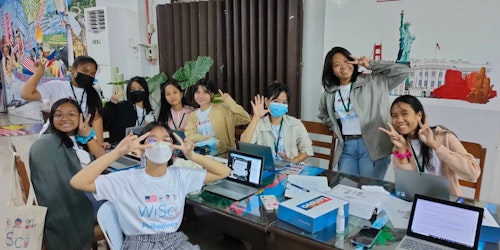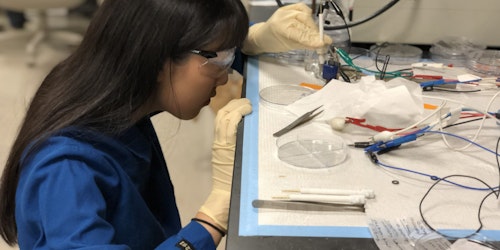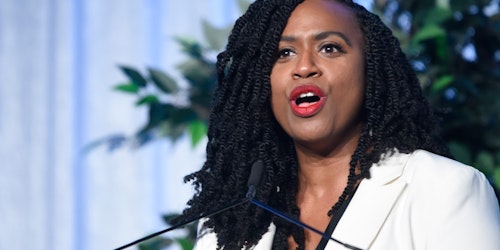Originally published in the Stanford Social Innovation Review at ssir.org.
Employment in science, technology, engineering, and mathematics (STEM) fields in the United States is not equitable. Women, particularly Black and Hispanic women, are underrepresented in many sub-sectors of STEM and face larger wage gaps than in other fields. They are also far likelier than men and women in other fields to report workplace discrimination, including feeling isolated, being treated as incompetent, and getting passed over for promotions.
These inequities are not new. STEM’s lack of diversity, equity, and inclusion (DEI) is often attributed in part to a “leaky pipeline”—the idea that despite interest and the ability to succeed in STEM careers, women tend not to pursue or remain in them. This metaphor, which has circulated for decades, draws attention to decision-making moments when women divert from STEM paths, such as when declaring an undergraduate major or starting a family. But while life decisions like these have ripple effects on women’s careers—and while we need to better support them and others historically excluded from STEM to enter and remain in the field—the lack of diversity in STEM isn’t just about individual choices. It’s also about systemic barriers and layers of biases.
The impact of these barriers and biases extends beyond workplaces; they shape STEM products and innovations themselves. Multiple studies have shown that gender and racial bias in product design can have significant, even deadly, effects. Examples include seatbelts that don’t protect shorter drivers from accidents, PPE equipment that doesn’t fit the faces of female nurses, and even body armor that doesn’t effectively protect women in law enforcement. An emerging body of evidence suggests that we can trace product bias to a lack of inclusion in product design teams. A study that analyzed biomedical patents filed in the United States between 1976 and 2010, for example, found that teams made up of all-male inventors were substantially less likely to apply for patents for female consumer products compared to all-women teams.
As advances in medicine, artificial intelligence, and other STEM sectors continue to shape our world, we must ensure that the field is poised to reduce, not deepen, inequities. Our ability to harness these new solutions and confront the STEM challenges of tomorrow may indeed hinge on the problem-solving power of diverse teams.
We propose three strategies that can effectively promote diversity, equity, and inclusion (DEI) for women, especially women of color, in STEM in the United States. These include reframing the face of technology, scaling up early career interventions, and reforming recruitment and workplace culture. These strategies are based on more than 60 first-hand accounts of women of color working in STEM fields; 500 first-hand accounts of women leaders across sectors; a review of literature on diversity in STEM; and our collective experiences as strategists, innovators, and women’s rights experts. Each strategy targets the systems and structures that shape STEM fields. Together, they form a set of actionable steps that executive directors, school administrators, university deans, CEOs of STEM companies, and others involved with STEM institutions can take to create change.
1. Reframing the Face of Technology
People of all races and genders predominantly perceive the face of technology as young, white, middle-class, and male—a perception originating in the outsized representation of young white men in technology and reinforced by advertising. This narrative has buried the significant contributions of diverse leaders who have shaped the field’s past and present.
One possible contributing factor is the “Matilda Effect,” a term coined in 1993 and cited hundreds of times since to describe the misattribution of female scientists’ work to their male colleagues. Meanwhile, Harvard research found that both male and female graduate students in the United States perceived research by male authors as inherently stronger. This kind of bias contributes to the systemic under-recognition of female scientists and obscures the generations of “hidden figures” (including Black women who powered NASA as human “computers” in the mid- 20th century) whose contributions to STEM have been ignored, undermined, or misattributed.
Unfortunately, there is no widely understood counternarrative that communicates the power and potential of a diverse STEM workforce. This generates two problems. First, it holds back many women and women of color from envisioning a future in STEM. For example, stereotype threat—the fear of bolstering negative perceptions of a group you belong to—and social norms that classify aptitude and excitement about math and science as male traits can convince young girls they don’t belong in STEM. This creates a “confidence gap” that can persist well into a woman’s career. Women we interviewed highlighted experiences where male teachers discouraged them from pursuing STEM or reinforced the notion that STEM careers were a better fit for men.
Second, the absence of an aspirational narrative means that many STEM institutions and leaders aren’t compelled to deeply invest in DEI. Following the murder of George Floyd, many companies made commitments to racial equity and invested in women of color, but the overall investment was minuscule in comparison to their bottom lines. Indeed, many tech companies committed only a day’s worth, or less, of profits.
We have an opportunity to frame STEM’s lack of diversity in a way that paints an aspirational narrative of what is possible, but getting there demands accountability from leaders, institutions, and systems. It involves centering those responsible for change, and better contextualizing the problem’s roots and manifestations. For example, instead of saying, “Fewer than 5 percent of Silicon Valley CEOs are women,” we can say, “Despite decades of pledges to increase diversity among their ranks, tech companies are still 20 times likelier to hire or promote a man as CEO than a woman.” This reframing casts leaders as the active agents they are in shaping recruiting and retention systems, without placing the focus purely on excluded people. Vodafone’s #ChangetheFace campaign, which calls on technology leaders to diversify the technology industry, provides an example of where organizations can start.
At the same time, we must build and entrench a narrative of the power that women of color can bring to STEM. One way to do this is by highlighting the accomplishments of female scientists of color. Our interviews with women of color across the field revealed that their experiences, insights, and ways of working matter to the future of STEM; they can drive the development of new products and innovations for diverse users, and are well-poised to facilitate cultural shifts through inclusive, empathetic leadership. As Tricia Fernandez, senior IT project manager at T-Mobile, put it, “I think being a girl [in STEM] is actually advantageous … we think differently, and we put emotions into our decisions; we don’t just go for faster or taller or bigger.” Showcasing the perspectives and abilities of women of color through initiatives like the Smithsonian’s recently launched “Women’s Future Month” can help pull them into the public discourse.
We can learn from parallel efforts. For example, the now-widely held understanding that investing in girls’ education lifts up families and communities and that countries that support girls’ education can benefit economically shows that narrative change is possible. This concept, which was new to the discourse in the 1990s, is now a mainstream idea that large social change influencers like the World Economic Forum, Brookings, and the United Nations have accepted and embraced.
2. Scaling Up Early Career Interventions
Girls, particularly girls of color, don’t always believe that STEM is a career choice they can pursue and succeed at. Changing this requires deliberate investment, and it starts with nurturing their ambition through classroom and extracurricular programming. Programs need to emphasize the wide range of industries and solutions STEM enables, as well as the ways in which girls’ strengths and perspectives can be important in STEM careers.
Creating spaces for girls to develop and fuel their intellectual curiosity—and providing thoughtful mentorship along the way—can go far. Several of the STEM leaders we interviewed told stories of pivotal moments when a teacher, counselor, or mentor said, “You’re really good at this. Have you thought about pursuing it as a career?”
Interventions that bolster young women’s feeling of belonging in STEM are perhaps especially important at the post-secondary and early-career levels. Encouraging educators and administrators to identify and nurture the STEM talents of girls and students of color through connecting them with extracurricular programs like Girls Who Code can build the “scaffolding” girls need to reach new goals.
For example, Gabrielle Lyon’s organization, Project Exploration, aims to “change the face of science” by connecting middle- and high-school students of color with STEM professionals from their own Chicago communities, through a thoughtful array of mentorship and enrichment programming. A ten-year longitudinal study showed that program alumni—primarily young women of color—were three times as likely to enroll in a four-year college than their peers and that more than one-third went on to major in a STEM-related discipline. This success is a testament, in part, to the impact that sustained mentorship in one’s own community can have.
Building more inclusive classrooms and workspaces is also important. Research shows that adjusting elements of STEM curriculum and learning spaces can increase girls’ sense of belonging. Harvey Mudd College, for example, redesigned its computer science programming to make it feel more inclusive, including shifting the title of its “Introduction to Symbolic Programming” course to “Beauty and the Joy of Computing. These changes helped the college increase the percentage of women pursuing computer science majors from 10 percent to more than 50 percent in less than a decade.
Programming that allows young women in STEM to connect with each other also nurtures a sense of belonging, which can help them overcome both the implicit and explicit messaging that frames the face of STEM as white and male. In her time as a student and intern, Donna Stokes, a professor of physics and associate dean at Houston University, participated in a program that brought together 20 underrepresented students to participate in summer research. She says, “It gave me the opportunity to see what research was all about in a different environment than a university, and it also exposed me to more students like myself…. We all built a cohort [that] we use even now as a network.” Programs like STEM camps for young girls, undergraduate summer research experiences, and post-graduate “bridge” programs all help nurture confidence and connection.
Finally, girls and young women also need opportunities to learn how to lead, not just for the leadership roles they’ll hold in the future, but to contribute their strengths and perspectives today. The UN Foundation girls’ empowerment movement Girl Up exemplifies how organizations can put girls at the heart of their strategy. The foundation’s global teen advisory board and network of 5,000 girl-led clubs across 130 countries help drive its programming and advocacy.
Digital technology can help scale efforts like these and ensure that more young women benefit from them. Organizations can use online learning and virtual mentorship tools, and efficiently share and stream STEM programming to reach young people. Career Girls, for example, aims to close what it calls the “imagination gap” for girls, especially girls of color, through globally available, video-based career exploration and readiness tools. These include a library of videos highlighting the career paths, candid stories, and advice of 500 women role models with different backgrounds and experiences, as well as resources for teachers and students. Digital programming has enabled the organization to reach 13 million girls in more than 232 countries and territories, and early evidence from its inaugural Artificial Intelligence, Machine Learning and Robotics virtual camp with 30 girls in the United States shows an 18 percent increase in career exploration and goal setting following participation.
3. Reforming Recruitment and Workplace Culture
Even though 8 in 10 Americans view racial and ethnic diversity in the workplace as at least somewhat important, and 45 percent of people believe diversity is important to organizational success, gender and racial bias continue to pervade recruitment processes in STEM fields. One study found that both men and women were twice as likely to hire a man for a job that required math, and a growing body of evidence shows that people of color who “whiten” their resumes by scrubbing references or clues to their race are far likelier to hear from recruiters. For women of color in STEM, poor recruitment rates often reflect a lack of effort on the part of hiring managers rather than a shortage of talent. And when women of color do enter STEM institutions, they often receive lower pay and worse treatment than their white or male counterparts.
The evolution of the #MeToo movement and the racial reckoning of 2020 have made conversations around systemic gender bias and racism more mainstream within corporate America. Now companies need to actively take on the challenging, long-term task of creating a new kind of workplace that allows women and people of color to thrive. The cross-industry working group Catalyze Tech offers some useful ways to build more inclusive workplaces, including:
- Modeling and incentivizing inclusive leadership (for example, by tying executive compensation to DEI metrics)
- Operationalizing DEI throughout the organization (for example, by including DEI as part of performance evaluations)
- Sharing DEI data, metrics, and goals to strengthen organizational accountability
Research from the social impact advisory firm Dalberg supports similar recommendations.
We can also draw lessons from other sectors. For one, naming and measuring the issue—openly acknowledging that your organization isn’t diverse and equitable—is a common first step toward greater inclusivity, and a good example comes from the field of media. Troubled by the lack of female voices on his flagship nightly news broadcast Outside Source, in 2019, BBC presenter Ros Atkins set a goal of 50-50 representation of women and men as featured contributors. At the end of each show, the news team began sharing the ratio of female to male contributors with viewers, creating a powerful mechanism of accountability that ultimately pushed them to increase female representation from 39 percent in January 2019 to 51 percent by April. This approach soon prompted more than 50 other organizations to do the same as part of the 50:50 The Equality Project.
In the legal field, the Mansfield Rule measures whether law firms have considered hiring at least 30 percent women, lawyers of color, LGBTQ lawyers, and lawyers with disabilities for leadership positions. Since its launch in 2016, 118 major firms have joined the initiative, and the vast majority have reported marked improvements in diversity among their pitch teams, lateral hiring pool, and equity partner promotions. STEM institutions can consider similar strategies that track DEI goals regularly and transparently, creating incentives for leaders to deliver on their commitments.
One promising strategy for strengthening the recruitment and retention of scientists from historically excluded backgrounds is cluster hiring. Academic and research institutions hire staff as a cohort to work collaboratively across disciplines, often considering a commitment to DEI in its selection criteria. By actively prioritizing diverse perspectives and cultivating community among cohort members, some institutions have been able to improve the retention of faculty of color. As STEM institutions within and beyond academia work to retain a diverse workforce, they must look inward to align their organizational policies and cultural practices in support of that goal. This could look like reforming benefits and formalizing flexible work for caregivers, adapting performance measurement systems to account for different leadership styles and root out bias, or creating checks for bias in product design.
Ultimately, shifting our language and narratives, scaling investments in young leaders, and upping the accountability in workplaces all contribute to the broader goal of advancing the leadership of women, particularly women of color, and other underrepresented groups in STEM. These strategies represent a departure from efforts to plug the “leaky pipeline” of women and girls leaving STEM, challenging us instead to rebuild the sector’s “scaffolding”—the narratives, systems, and institutional practices too often holding back their contributions and leadership across the field. It is through this kind of transformation that women will see concrete increases in employment, wages, and power, reversing the trends seen in the last few years and laying the foundation for a more inclusive tomorrow. As we confront the profound STEM challenges that lay ahead—new pandemics, climate change, cancer, and cybersecurity threats, among others—the stakes could not be higher. We must come together to meet this moment with the full potential of a diverse and empowered workforce.
Read more stories by Linda Calhoun, Shruthi Jayaram & Girl Up Teen Advisor Alum Natasha Madorsky.
Linda Calhoun is the founder and CEO of Career Girls, a nonprofit providing comprehensive video-based career exploration and readiness tools for girls, featuring the experiences of diverse and accomplished women role models. In this role, she has interviewed more than 500 women in various professions, emphasizing STEM careers.
Shruthi Jayaram is an associate partner at Dalberg Advisors and the co-lead of Dalberg’s gender equity practice. She has worked with foundations, multi-lateral agencies, nonprofits, movement leaders, and companies to develop strategies and initiatives that advance women’s rights and ability to realize their full potential.
Natasha Madorsky is a senior consultant at Dalberg Advisors focused on global health, gender equity, and public-private partnerships. She has worked with governments, foundations, multilateral agencies, and private companies on strategic planning, and has supported girls’ empowerment and STEM programming across the globe.








